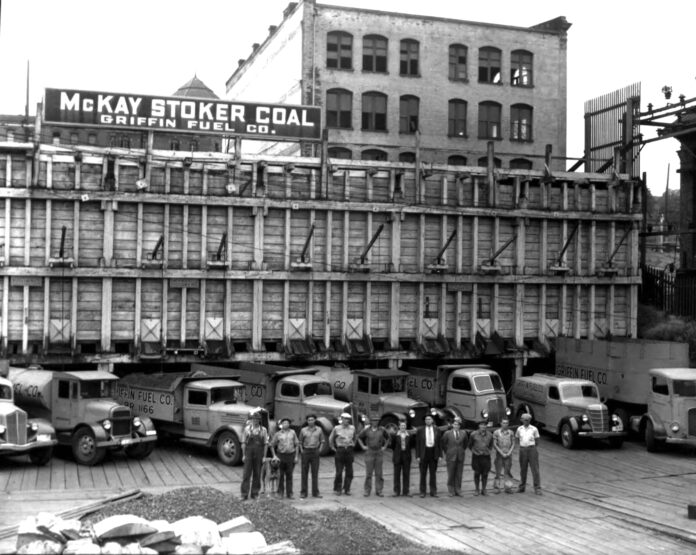Over the past several weeks, this column has examined the evolution of residential heating with a series of photos featuring the Bell Fuel and Griffin Fuel companies of Tacoma. When this Aug. 21, 1940 photo of Griffin Fuel’s operations was shot, residential heating for 78% of U.S. homes was dominated by two solid fuels, coal and wood. Of the two fuels, coal was the more dominant heating 55% of homes, while firewood warmed 23%. Fuel oil (i.e., diesel or kerosine) and natural gas furnished the remaining 22%.
Located at 1910 Commerce Street in downtown Tacoma, Griffin Fuel Company was one of the largest fuel delivery firms in Washington, with offices in Seattle and Tacoma. By 1949, Griffin Fuel owned 100 trucks and pieces of equipment. The storage bins above the row of delivery trucks were filled with coal, which usually came in three sizes, stoker, nut, and lump. Stoker coal, typically the size of marbles, was by far the most important source for heating homes and businesses. It was used in automated burners, called stokers with coal augured from a hopper bin into the firebox, all controlled by a thermostat. Coal still needed to be shoveled into the hopper and each day the buildup of ash and clinkers was removed. But that was still a far cry easier than cutting, splitting, and loading wood into fireplaces or stoves, which required continued supervision with uneven heating results.
As always, change was in the air, particularly in the Pacific Northwest where over 100 hydroelectric dams were built on the Columbia and many other rivers throughout the region. Electricity transmitted on huge power lines soon brought cheaper and more convenient ways to heat homes in the Pacific Northwest. Then in the early 1950s, natural gas pipelines reached Washington providing a new and cleaner source.
Both electricity and natural gas had natural advantages over fuels like coal, wood, or diesel oil, primarily the automatic delivery by wire or pipeline. Coal, wood, and fuel oil required expensive transportation, handling, and storage, while electricity and gas were automatically available by turning a switch. Both were cleaner and required almost no homeowner effort, particularly when compared to coal or wood.
But, swapping out one home’s heating furnace for another wasn’t cheap, so homeowner migration to electric and natural gas furnaces took time. However, today in Washington State over 91% of homes are heated with either electricity or natural gas, while fuel oil, wood, coal, and other fuels combined account for less than 5%. Despite its bright allure, solar energy for home heating in Washington is negligible at 0.14%.
This photo number D10149-4 was taken by Nelson Richards of Richards Studio and comes courtesy of the Northwest Room at the Tacoma Public Library.







